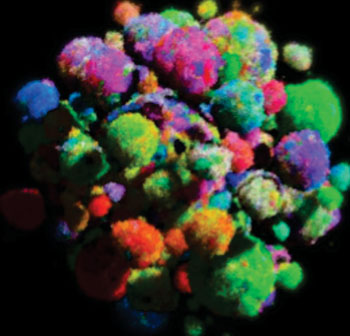Computer Models Help Explain How Tumors Evolve
By LabMedica International staff writers
Posted on 10 Sep 2015
Cancer researchers used computer modeling to create three-dimensional simulations of tumors developing over time in order to explain why the tumor mass is almost exclusively composed of one type of cell while a similar mass of normal tissue would be composed of many cell types.Posted on 10 Sep 2015
Most cancers in humans are large, measuring centimeters in diameter, and composed of many billions of cells. An equivalent mass of normal cells would be highly heterogeneous as a result of the mutations that occur during each cell division. What is remarkable about cancers is that virtually every cell within a large tumor often contains the same core set of genetic alterations, with heterogeneity confined to mutations that emerge late during tumor growth. How such alterations expand within the spatially constrained three-dimensional architecture of a tumor, and come to dominate a large, pre-existing lesion, has been unclear.

Image: A three-dimensional model of a tumor showing cell types in varying colors (Photo courtesy of Dr. Bartlomiej Waclaw and Dr. Martin A. Nowak, the University of Edinburgh).
An international team of investigators from the University of Edinburgh (United Kingdom), Harvard University (Cambridge, MA, USA), and Johns Hopkins University (Baltimore, MD, USA) developed computer models to describe how short-range dispersal and cell turnover could account for rapid cell mixing inside the tumor during its evolution.
The investigators reported in the August 26, 2015, online edition of the journal Nature that a small selective advantage of a single cell within a large tumor would allow the descendants of that cell to replace the precursor mass in a clinically relevant time frame. They also demonstrated that the same mechanisms could be responsible for the rapid onset of resistance to chemotherapy.
The investigators stated that their model not only provided insights into spatial and temporal aspects of tumor growth, but also suggested that targeting short-range cellular migratory activity could have marked effects on tumor growth rates.
First author Dr. Bartlomiej Waclaw, a researcher in the school of physics and astronomy at the University of Edinburgh, said, "Computer modeling of cancer enables us to gain valuable insight into how this complex disease develops over time and in three dimensions."
Related Links:
University of Edinburgh
Harvard University
Johns Hopkins University













